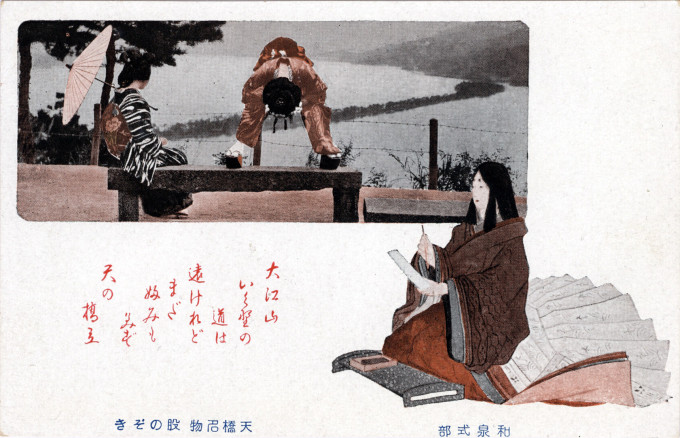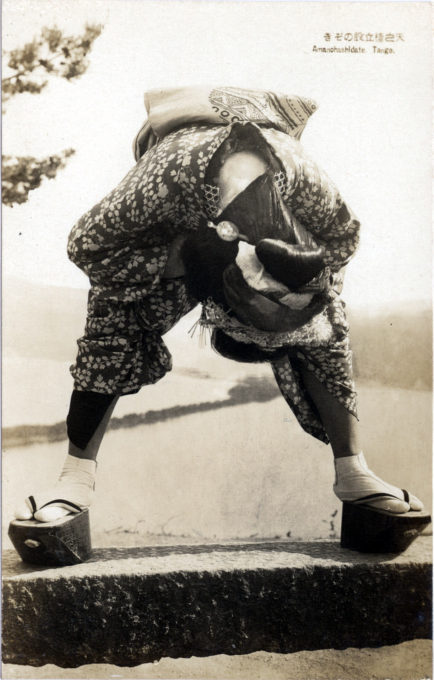
A depiction of poetess Koshikibu no Naishi; her poem about one of Japan’s three most beautiful scenes, Ama-no-Hashidate; and the creative posturing used for viewing the scene. “If you bend over and try to look at the view through your legs, it is said that Ama-no-hashidate will appear like a bridge to the heavens.”
“The scenic Ama-no-hashidate sand bar is located in the northern part of Kyoto Prefecture, on Miyazu Bay, facing the Sea of Japan. It is a 3-kilometer-long and 40- to 100-meter-wide sand spit, stretching into Miyazu Bay from Ejiri on the Tango-hanto Peninsula.
“It was formed by sand accumulated by the tides and wind. The over 8,000 pine trees growing on this white sand spit appear like a bridge over the ocean, creating a place of incomparable beauty called Hakusha-Seisho, which means ‘white sand and green trees’. The area is said to be one of the three most beautiful spots in Japan, together with Miyajima in Hiroshima and Matsushima in Miyagi.
“If you bend over and try to look at the view through your legs, it is said that Ama-no-hashidate will appear like a bridge to the heavens.”
– Japan: The Official Guide, Japan National Tourism Organization, 1941
“Lady-in-waiting Koshikibu no Naishi was the daughter of the acclaimed Heian-era poet Izumi Shikibu, one of the Thirty-six Medieval Poetry Immortals, and Tachibana no Michisada, the governor of Mutsu. Beginning around 1009, Koshikibu joined her mother in serving Empress Shōshi. A target of many suitors, Koshikibu eventually married Fujiwara no Kiminari. She bore him a child but died soon thereafter, still in her late twenties.
Viewing Ama-no-hashidate, c. 1920. “If you bend over and try to look at the view through your legs, it is said that Ama-no-hashidate will appear like a bridge to the heavens.”
“The story goes that Koshikibu was suspected of receiving help from her mother in composing poetry. On one occasion, during the absence of mother at Ama-no-Hashidate, Koshikibu was selected to take part in a poetry contest at the Imperial Court. A day or two before the event, a nobleman, Fujiwara Sadayori, laughingly asked her if she was not expecting a letter from her mother, hinting that Koshikibu could not otherwise be able to produce a poem good enough for the contest. Koshikibu, touching his sleeve, improvised the verses below.
“The impromptu poem included a triple pun on the famous scenic places: Ama-no-Hashidate, the picturesque bay in the Province of Tango; and the mountains Oeyama and Ikuno, on the road from the imperial capital, Kyoto. The resulting poem by her was included as No. 60 in Fujiwara no Teika’s Ogura Hyakunin Isshu [100 Poems].”
大江山
いくの野の道のとほければ
まだふみも見ず
天の橋立Both Mount Oe
and the road to Ikuno are far away.
I’ve never been there,
nor has word come from Ama no hashidate.– Wikipedia


